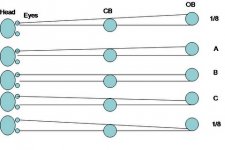Absolutely absurd. I guess that is easier and less humbling than to say "I apparently have no clue how this works." John, while it would take more work to actually figure out the math and geometry to explain how it works at a higher level of abstraction, one could easily work out the angles with some graph paper. You could take whatever sample size you decide you have the time for and graph it out for that many shots at various points of the table. One can certainly determine the aim line for the OB to the pocket. From there, it is easy to determine the theoretically correct line of the CB to the OB necessary to pocket the shot. Obviously, that yields the line of the cue stick through CCB. Now just work backwards by reversing the pivot and seeing if that line backs into the visuals.
We should put together a pool for people to donate to in order to raise $1000 or so. We then contact the Math Department at a technical or engineering school. Offer the $1000 as a scholarship to one of their students that can describe the math and geometry. First one correctly submitted wins. I would predict it would take less than 5 days to get a correct answer back.
I will donate $100 toward the "math prize" for the equation to CTE. Only problem is that I would have zero clue as to the validity of any equation put forth.
Let me share a few that have been helpful (not) to me over the years. I keep these as powerpoints on my laptop whenever I meet anyone who could use some tips on how to play pool.
I can't find the one that was done for Ghost Ball, someone posted what they said was the exact formula that governs Ghost Ball. I have saved it somewhere and when I find it I intend to make a poster of it that I hope will hang in every pool room in the world.
Here is what it ALL boils down to for me.
If I tell a person that they should imagine a ball to aim to and they start making everything they shoot at then I find that to be awesome. Neither they nor I needs to know any more about the details of why this works.
If I tell a person to start with the edge and pick one of three secondary points and slide into the shot and this works for them then I find that to be awesome and neither of us needs to know any more about why this works.
Every person is the same and every person is different. I can ask you to tell me how long a board is and you might say it's 4ft and another person might guess 3 feet. Then I ask for the middle to be marked and people can be off by more than an inch.
However if I put a tiny almost imperceptible dot right in the center then the margin of error decreases tremendously because the viewer has something objective to orient to.
Since as far as we know math rules the universe then of course math rules how we can start with a fixed cue ball and have two different angles to the pocket and end up on the shot line for either shot using the exact same steps for both shots. But we as shooters don't need to know that math. We simply follow the directions and shoot the white ball straight and the object ball falls in.
As we advance as players or as we decently advanced players figure out that this does really work and we place our trust in it then we figure out the little nuances and times when we would WANT to deliberately adjust. To give a little juice here, account for cloth conditions there, cheat the pocket a little here, cinch the shot.....etc.... But the method gives us a rock solid way to get on the shot line we feel comfortable with.
Now, some people will never get it. They will never be able to let go of the real need to understand the math or have some hard explanation of why it works. Using terms like visual intelligence and rotating centers and visual sweeps is too imprecise for them. They view the world in terms of either that which is measured and that which is estimated. That's just how some people are. They can't let go and follow directions and try to experience it through doing.
I am 50/50 on the fence. It drives me absolutely nuts that I don't have a better explanation of WHY Hal's/Stan's methods work. I have been plagued by this for ten years. But, they work and work freaking awesomely.
That's why I am so disappointed that Dr. Dave does not treat this with the same amount of diligence that he has done with all the other aspects of pool.
Maybe it's because the effects of crashing pool balls and sticks striking balls are easy to film and observe but it's not feasible to get into a person's mind and see what is going on when they are simply standing and looking at a shot. It's possible to image the brain activity of a CTE user and Ghost Ball user but that won't explain the mechanics.
However what Dave COULD do is film a diehard and expert CTE user from multiple angles approaching and shooting many reference shots to break down the exact mechanics. He could move the balls a few inches and record what the shooter does and thus at see IF there is a detectable difference that makes a difference.
But we won't see that happening any time soon if ever. Unfortunately.





